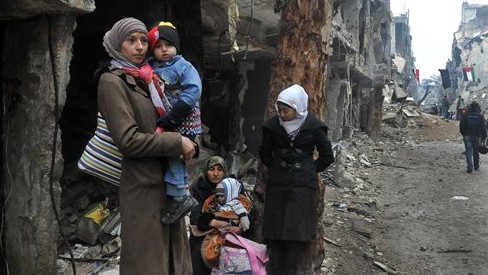Roudy
Diamond Member
- Mar 16, 2012
- 59,891
- 18,117
- 2,250
Archaeological Evidence of a Jewish Jerusalem


Ancient Jewish mosaic in Israel Museum
Archaeological evidence shows that from antiquity to the present Jerusalem has been capital of the Jewish people.
The Jewish presence in Jerusalem dates as far back as 1000 BCE to the reign of King David as verified by archaeological excavations performed within the City of David, the Temple Mount area, Solomon’s Stables, within the Old City and elsewhere. According to the American archaeologist Eric Cline, writing in Jerusalem Besieged, “In 1993 and 1994, archaeologists excavating at Tel Dan in northern Israel discovered an inscription that commemorates a military campaign in Israel by Hazael of Aram about the year 841 BCE and that mentions the House of David.” Tel Aviv University ancient historian Nadav Na’aman has stated based on this excavation that, in his opinion, the facts “strongly support the biblical claims a) that David conquered Jerusalem and made it his capital and b) that he founded the royal dynasty of Jerusalem.”
Since the Tel Dan excavation in 2010 Dr. Eilat Mazar, a Hebrew University of Jerusalem archaeologist discovered a wall dating from the time of King Solomon and stated that this finding was “the first time that a structure from that time has been found that may correlate with written descriptions of Solomon’s building in Jerusalem.” In addition, archaeologists excavating at Khirbet Qeiyafa in Judea and Samaria unearthed a fortified city that provided physical proof for the fact that the Jewish people practiced different religious beliefs from their Canaanite and Philistine neighbors. According to Prof. Yosef Garfinkel, ‘This is the first time that archaeologists uncovered a fortified city in Judah from the time of King David. Even in Jerusalem we do not have a clear fortified city from his period. Thus, various suggestions that completely deny the biblical tradition regarding King David and argue that he was a mythological figure, or just a leader of a small tribe, are now shown to be wrong.”
 Eric Cline in his book Jerusalem Besieged mentions that in Sennacherib’s Tomb there is an inscription that offers Extra-Biblical archaeological proof for the Assyrians under the reign of King Hezekiah besieging but not capturing Jerusalem in the 7th century BCE. It reads, “In my third campaign, I marched against Hatti (Syria-Palestine). As for Hezekiah, the Judean, who had not submitted to my yoke, I besieged forty-six of his fortified walled and surrounding small towns, which were without number. I took out 200,150 people, young and old, male and female, horses, mules, donkeys, camels, cattle and sheep without number, and counted them as spoil. Himself (Hezekiah), I locked him up within Jerusalem, his royal city, like a bird in a cage.”
Eric Cline in his book Jerusalem Besieged mentions that in Sennacherib’s Tomb there is an inscription that offers Extra-Biblical archaeological proof for the Assyrians under the reign of King Hezekiah besieging but not capturing Jerusalem in the 7th century BCE. It reads, “In my third campaign, I marched against Hatti (Syria-Palestine). As for Hezekiah, the Judean, who had not submitted to my yoke, I besieged forty-six of his fortified walled and surrounding small towns, which were without number. I took out 200,150 people, young and old, male and female, horses, mules, donkeys, camels, cattle and sheep without number, and counted them as spoil. Himself (Hezekiah), I locked him up within Jerusalem, his royal city, like a bird in a cage.”
The story of the Jewish people in Israel and Jerusalem as told by archeological evidence continues forward through time. In 586 BCE, Nebuchadnezzar destroyed the Kingdom of Judah and sent a good part of its population into exile. According to Eric Cline, “Archaeological evidence from many sites in modern Israel paints a grim picture of destruction throughout the land. Rubble-strewn houses with fire-blackened toppled walls were all that remained of once prosperous villages.” If one visits the Israel Museum, one can witness ancient Babylonian arrow-heads on display, along with other archaeological proof for the destruction of the Kingdom of Judah. However, not too long after the Babylonian destruction, the Jewish people would return to their ancestral homeland.

Ancient Jewish Temple
Inside the Israel Museum, one can find much archaeological evidence for the ancient Jewish presence within the city of Jerusalem: Hasmonean-era coins, ancient correspondences mentioning the Jewish people, and even Roman-era mikvah baths. Within Jerusalem’s Old City, one can also find proof of the Roman destruction. According to Eric Cline, “Nahman Avigad and his team of archaeologists found the severed arm of a young woman in her twenties who had died nearly two thousand years ago. That was all, just an arm—with the hand and fingers still attached. It lay in a room filled with ash and soot. In a nearby room, a spear was propped up against the wall. Other rooms contained utensils of daily living, all covered by a thick layer of ash and debris from the fire that destroyed the ancient dwelling. The house had belonged to a well-to-do family, probably by the name of Bar Kathros. Coins were scattered on the floor. Some bore the inscription ‘year four of the redemption of Zion,’ indicating that they were minted in the year 69 CE, in the fourth year of the Jewish rebellion against the Romans.”
It is no surprise that recently construction at Jerusalem’s Central Bus Station had to be halted after workers uncovered another ancient site connected to Jewish history.


Ancient Jewish mosaic in Israel Museum
Archaeological evidence shows that from antiquity to the present Jerusalem has been capital of the Jewish people.
The Jewish presence in Jerusalem dates as far back as 1000 BCE to the reign of King David as verified by archaeological excavations performed within the City of David, the Temple Mount area, Solomon’s Stables, within the Old City and elsewhere. According to the American archaeologist Eric Cline, writing in Jerusalem Besieged, “In 1993 and 1994, archaeologists excavating at Tel Dan in northern Israel discovered an inscription that commemorates a military campaign in Israel by Hazael of Aram about the year 841 BCE and that mentions the House of David.” Tel Aviv University ancient historian Nadav Na’aman has stated based on this excavation that, in his opinion, the facts “strongly support the biblical claims a) that David conquered Jerusalem and made it his capital and b) that he founded the royal dynasty of Jerusalem.”
Since the Tel Dan excavation in 2010 Dr. Eilat Mazar, a Hebrew University of Jerusalem archaeologist discovered a wall dating from the time of King Solomon and stated that this finding was “the first time that a structure from that time has been found that may correlate with written descriptions of Solomon’s building in Jerusalem.” In addition, archaeologists excavating at Khirbet Qeiyafa in Judea and Samaria unearthed a fortified city that provided physical proof for the fact that the Jewish people practiced different religious beliefs from their Canaanite and Philistine neighbors. According to Prof. Yosef Garfinkel, ‘This is the first time that archaeologists uncovered a fortified city in Judah from the time of King David. Even in Jerusalem we do not have a clear fortified city from his period. Thus, various suggestions that completely deny the biblical tradition regarding King David and argue that he was a mythological figure, or just a leader of a small tribe, are now shown to be wrong.”

The story of the Jewish people in Israel and Jerusalem as told by archeological evidence continues forward through time. In 586 BCE, Nebuchadnezzar destroyed the Kingdom of Judah and sent a good part of its population into exile. According to Eric Cline, “Archaeological evidence from many sites in modern Israel paints a grim picture of destruction throughout the land. Rubble-strewn houses with fire-blackened toppled walls were all that remained of once prosperous villages.” If one visits the Israel Museum, one can witness ancient Babylonian arrow-heads on display, along with other archaeological proof for the destruction of the Kingdom of Judah. However, not too long after the Babylonian destruction, the Jewish people would return to their ancestral homeland.

Ancient Jewish Temple
Inside the Israel Museum, one can find much archaeological evidence for the ancient Jewish presence within the city of Jerusalem: Hasmonean-era coins, ancient correspondences mentioning the Jewish people, and even Roman-era mikvah baths. Within Jerusalem’s Old City, one can also find proof of the Roman destruction. According to Eric Cline, “Nahman Avigad and his team of archaeologists found the severed arm of a young woman in her twenties who had died nearly two thousand years ago. That was all, just an arm—with the hand and fingers still attached. It lay in a room filled with ash and soot. In a nearby room, a spear was propped up against the wall. Other rooms contained utensils of daily living, all covered by a thick layer of ash and debris from the fire that destroyed the ancient dwelling. The house had belonged to a well-to-do family, probably by the name of Bar Kathros. Coins were scattered on the floor. Some bore the inscription ‘year four of the redemption of Zion,’ indicating that they were minted in the year 69 CE, in the fourth year of the Jewish rebellion against the Romans.”
It is no surprise that recently construction at Jerusalem’s Central Bus Station had to be halted after workers uncovered another ancient site connected to Jewish history.

















